

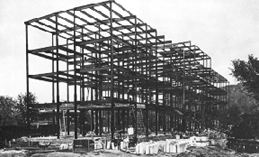
West Wing superstructure - May 1924
The three units of the capitol complex were let as separate contracts, financed, built and inspected before beginning the next phase. A remarkable aspect of the project is that each unit was built for less than the legislative appropriation, a fact that the architect and the commission were proud of. The west wing was erected between January 1924 and March 1925 for a cost of $1,218,171.32; the east wing from July 1926 to December 1927 at a cost of $1,361,425.00; and the main unit from March 1930 to February 1932 for $4,482,623.21. These figures represent all charges for materials, labor and fees, and coupled with the costs of land acquisition and beautification, West Virginia invested a gross sum of $9,491,180.03 for one of the nation's most beautiful and functional capitols.
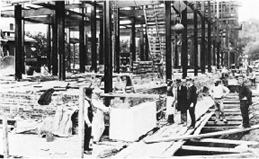
Laying of West Wing cornerstone - May 1924
When excavations were begun near old Duffy Street, particular care was taken in using the earth removed for the basement of the west wing for filling the open basements left by the removal of structures on the site. Every tree on the plot that did not come down to make way for the complex was carefully boxed, marked and indicated on the contractor's maps, and every flowering bush and shrub was saved for the ultimate beautifying of the grounds. While the nearby residents in Charleston's east end would have to suffer the eyesores of muddy ditches, piles of debris and stacks of stone and steel for several years to come, they were afforded the rare opportunity of witnessing the erection of buildings unlike anything ever seen in this region of the country, and they were given the promise that the grounds of the capitol would someday rival the magnificence of any park in the state.
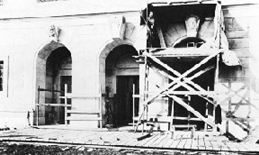
Carvings above the West Wing entrance -
January 1925(the sculptor worked from the plaster
model at the left of the scaffold measuring with
calipers and his own skilled eye)
Early in the year of 1924, immense cranes were moved on to the site and an army of steelworkers assembled the superstructure above the fifteen hundred yards of concrete poured for the foundation. A circular track of rails curving into the grounds from the New York Central Railroad at California Avenue had carried the cranes, other heavy equipment, and the structural steel, and was now busily hauling the carloads of limestone and marble from points around the country. The four-story plus basement, three hundred feet by sixty feet structure, was quickly rising to its full height of sixty-seven feet, and the traditional laying of the cornerstone for the wing was held on the first of May in 1924. Work proceeded on schedule for the remainder of the year as the building was under roof by the fall and the details of finishing the interior were well underway. By January of 1925, onlookers could witness some of the architectural artistry of the designer as the columns with their sculpted caps were set in place and the heads of mythological figures were carved in blocks of limestone above the entrances.
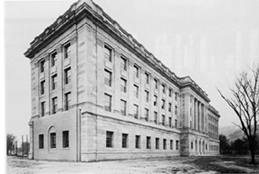
West Wing at completion - April 1925
With the west wing completed, moving day came for many of the departments and offices of the state, as permanent quarters were assigned in the 84,000 square feet of new floor space. The original departments to occupy the first wing were: the Superintendent of Free Schools; the Board of Control; the Auditor; the Bank Commissioner and the Tax Commissioner; offices of the Game and Fish Commission; and the Departments of Mines, Health, and Workmen's Compensation. Temporary quarters were established for the State Prohibition Department, the Commissioner of Agriculture and the State Police in the old George Lawton home (left standing on the capitol grounds through the construction period).
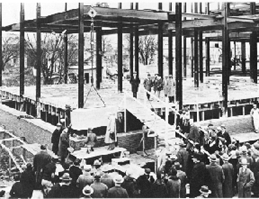
Laying of East Wing cornerstone - November 1926
presided over by William A. MacCorkle (with light
overcoat and goatee)
The office of the treasurer was to be located in the west wing, but Treasurer W. S. Johnson refused the offices, a highly publicized hitch in the project's chronology. He doubted that the single large safe, in the middle of a room which could be entered quite easily after only a few minutes of digging with an ice pick, was enough security for the money and important fiscal records of the state. Johnson cited the recent rampage of bank robberies around the country that were well publicized during the "roaring twenties" and felt that modern vault facilities would be necessary to carry out his official duties. To their credit, the Capitol Building Commission and the architect respected Johnson's refusal of the space, and made provisions to alter plans for the east wing to provide adequately secure quarters for the state treasury.
The second legislative appropriation was made and work on the east wing or unit number two was begun by the James Baird Company in July of 1926. Excavation, foundation laying and erection of the structural steel proceeded as efficiently as with the west wing, and after only four months of construction the cornerstone was laid on November 30, 1926. The dimensions and exterior design of the wing were exactly the same as the first structure, their entrances mirroring across a common expanse that formed the inner grounds of the U-shaped complex. With the exception of subtle decorative differences, the two wings appeared identical, but the interior layout and proposed uses for the second unit evidenced marked departures in design and function. Both wings of the complex were generally designated as office buildings, but within the plans of the east wing were the specific designs for suitable chambers for the Supreme Court, and the revised layout for the bank-like facilities of the treasury.
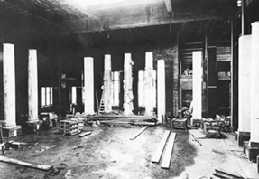
Preliminary work on the Supreme Court Chamber
- May 1927
Architect Gilbert took great care in planning the court chambers, personally designing its furnishings and decor. Above the chambers is a rectangular opening of stained glass, and bronze carvings depicting the "Scale and Balance" and the "Book of Law" adorn the sides of the skylight. In the frieze along the top of the walls in the chamber are the quotes: "THE TRUE FOUNDATION OF REPUBLICAN GOVERNMENT IS THE EQUAL RIGHT OF EVERY CITIZEN IN HIS PERSON AND PROPERTY AND IN THEIR MANAGEMENT: THOMAS JEFFERSON; FIRMNESS IN THE RIGHT AS GOD GIVES US TO SEE THE RIGHT: LINCOLN".
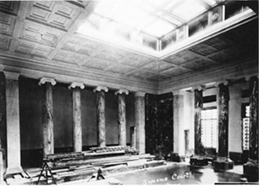
Supreme Court Chamber near completion
- August 1927
Columns of white Vermont marble with bases of black Belgian marble surround the room, and dark green (verd antique) marble, also from Vermont, make up the steps leading to the dais. Visitors to our U.S. Supreme Court chambers in Washington will notice a strong resemblance to the West Virginia court chambers, which is said by many to have been the model for the federal court facility designed by Gilbert several years later (the architect's final and crowning achievement prior to his death).
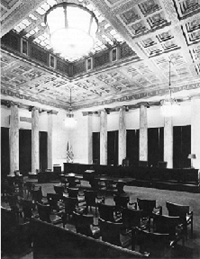
Supreme Court Chamber today
Gilbert had originally expressed some doubt as to whether Treasurer Johnson's requests could be carried out. The architect stated that it was impossible to construct a completely impregnable office, and that the structural reinforcements specified by the treasurer would make the ultimate cost of the wing prohibitive. Believing a common ground could be found, the commission solicited bids from contractors with bank construction experience, and found that the specialized work could be done for between thirty and forty thousand dollars. So the offices of the treasurer were built with security foremost in the design - the floors, walls and ceiling of the room housing the vault were lined with three layers of half-inch steel. The vault itself, twelve feet wide, seventeen feet long, and ten feet high, was completely surrounded with eighteen-inch walls reinforced with Wheeling crete steel. Forty separate safes were built within the vault, each with a double combination, and the access door was forged of solid steel, fifteen inches thick and weighing fifteen tons.
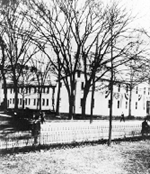
The Pasteboard Capitol
In March of 1927, the temporary or Pasteboard capitol, burned to the ground leaving many of the departments of state homeless once more. This event provided an impetus for completing the east wing, and in December of that year, the facility was ready for occupancy. The design differences of the new wing understandably added to its completion costs, and the commission accepted the building with the consent and pleasure of its new occupants in January of 1928. The first occupants of the new wing offices were employees and officials of the following departments: the Treasury and the State Road Commission on the first floor; the Department of Agriculture and the Public Service Commission on the second floor; and the State Supreme Court housed on the entire third floor. The design of the Supreme Court chambers allowed for a two-story equivalent in height, with the skylight opening on the east wing's roof. Space was allocated for the Department of Archives and History on the fourth floor, but the area remained vacant until June of 1929, when the department moved its body of materials from the Capitol Annex Building (already called the Charleston Library Building).

View ot the two completed wings - March 1930
Moving into the annex after the state archives were vacated were the offices of the State Bureau of Labor, the State Board of Children's Guardians, and the Adjutant General. When the capitol's main unit was completed the annex was completely
given over to the city of Charleston for its public library, and this building served Charleston's citizens until the mid 1960s, as it was also destroyed by fire. The National Bank of Commerce now stands on the site of the venerable annex building, a facility that preserved many of the records the state possesses that document our early history.